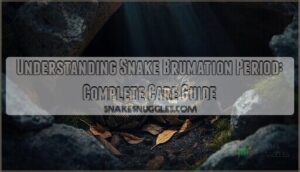This site is supported by our readers. We may earn a commission, at no cost to you, if you purchase through links.

The challenge lies in distinguishing between normal fasting patterns and genuine warning signs that demand intervention. Environmental miscalculations, hidden health problems, or simple seasonal changes can all trigger feeding refusals, and pinpointing the actual cause requires a systematic approach that eliminates the most common culprits first.
Table Of Contents
- Key Takeaways
- Reasons for Not Eating
- Hunger Status
- Food Preferences
- Environmental Factors
- Health Issues
- Breeding Season
- Shedding Cycle
- Feeding Techniques
- Behavioral Cues
- Troubleshooting Steps
- Frequently Asked Questions (FAQs)
- Why is my snake not eating?
- How long can a snake go without eating?
- What happens if a snake doesn’t eat for a long time?
- What should I do if my snake doesn’t eat?
- Do snakes eat if they are sick?
- What if a Snake refuses a meal?
- What should I do if my snake won’t eat?
- How do you stimulate a snake to eat?
- Is it normal for a snake to not eat for a month?
- How long can snakes safely go without eating?
- Conclusion
Key Takeaways
- Snakes can safely fast for weeks or months without medical concern, but refusal beyond six weeks with visible weight loss (over 10%) requires veterinary evaluation to rule out parasites, infections, or organ disease.
- Environmental issues—specifically incorrect temperature gradients, humidity levels, or disrupted light cycles—are the most common fixable causes of feeding refusal and should be verified before assuming illness.
- Natural behavioral patterns like pre-shed fasting (5-10 days), breeding season hormonal shifts, and seasonal metabolism changes explain most temporary appetite loss in healthy snakes without intervention needed.
- Troubleshooting feeding strikes requires methodical steps: verify husbandry parameters first, then experiment with prey variety, scent enhancers, and presentation timing before escalating to veterinary care.
Reasons for Not Eating
When your snake refuses food, it’s not always a red flag—but understanding why matters. The causes usually fall into three main categories: environmental problems, health issues, or natural behavioral patterns.
Let’s break down what might be going on with your snake.
Environmental Factors Impacting Appetite
Your snake’s environment isn’t just its home—it’s the foundation of its appetite, and even small missteps in temperature, humidity, or lighting can turn a healthy eater into a stubborn hunger-striker. Think of your enclosure as life support—when conditions drift from ideal, your snake’s body diverts energy from digestion to survival.
Your snake’s enclosure is life support—when conditions drift from ideal, its body diverts energy from digestion to survival
Critical environmental factors include:
- Temperature Control: Maintain proper thermal gradients with basking spots between 85-95°F and cool zones at 75-80°F, depending on species.
- Humidity Levels: Monitor enclosure moisture to prevent respiratory stress or dehydration that suppresses feeding.
- Lighting Cycles: Regulate photoperiod to honor natural day-night rhythms and seasonal behavioral patterns.
Health Conditions Affecting Feeding
Beyond environmental stress lies a more serious threat—underlying illness can shut down your snake’s appetite completely. Respiratory issues manifest as wheezing or nasal discharge, while mouth infections create painful oral lesions that make feeding impossible. Intestinal parasites drain nutrients and trigger inappetence, and intestinal blockages from improperly sized prey cause dangerous obstructions. Organ diseases and metabolic disorders disrupt normal digestion, requiring prompt snake disease diagnosis. Understanding snake health issues is vital for identifying the root cause of the problem.
| Health Condition | Warning Signs | Urgency Level |
|---|---|---|
| Respiratory Issues | Wheezing, nasal discharge, lethargy | High—seek vet within 48 hours |
| Mouth Infections (Stomatitis) | Oral lesions, drooling, facial swelling | High—painful condition |
| Intestinal Parasites/Blockages | Weight loss, regurgitation, dehydration | Moderate to High—depends on severity |
Don’t wait weeks hoping your snake rebounds—snake health issues deteriorate quickly without intervention.
Behavioral Feeding Patterns
Sometimes your snake isn’t sick or stressed—it’s just being a snake, and behavioral feeding patterns explain why perfectly healthy reptiles can fast for months without concern.
Natural snake feeding habits include predictable cycles influenced by behavioral triggers:
- Seasonal rhythms reduce appetite during winter months
- Pre-shed periods suppress food motivation for 5-10 days
- Breeding season redirects focus from eating habits to reproduction
- Age-related changes slow metabolism in mature snakes
- Individual preferences create unique feeding cues
Understanding these snake feeding patterns prevents unnecessary worry when appetite stimulation isn’t needed—your snake’s feeding refusal might simply reflect normal snake behavior, not snake appetite loss causes requiring intervention.
Hunger Status
Before you worry about what’s wrong, figure out if your snake is actually hungry in the first place. Snakes don’t eat on human schedules—their appetite loss follows specific feeding cycles that vary by species, age, and season.
Here’s what to check when your snake won’t eat:
- Recent feeding history: Adult pythons may eat every 2-4 weeks, while young colubrids need weekly meals. If your snake ate recently, inappetence isn’t alarming.
- Body condition: A healthy weight means your snake can skip meals without starvation effects. Feel for visible ribs or spine—that signals concern.
- Active hunting behavior: Watch for tongue flicking, prowling at feeding time, or tracking movement. These appetite signals indicate genuine hunger phases.
- Time since last shed: Snakes usually refuse food 5-10 days before shedding, then resume normal appetite afterward.
Understanding these refusal reasons helps you distinguish between natural fasting and problematic snake not eating patterns.
Food Preferences
Just like you wouldn’t devour every meal placed in front of you, your snake has distinct tastes that can make or break feeding time. Understanding prey preference helps you troubleshoot snake food refusal before assuming something’s seriously wrong.
Many snakes develop specific taste preferences based on what they ate as hatchlings. Your ball python might ignore mice completely while striking immediately at rats. Here’s how different prey types affect feeding cues:
| Prey Type | Best For |
|---|---|
| Mice | Smaller colubrids, young pythons |
| Rats | Adult pythons, larger boas |
| Chicks | Specialized feeders, food aversion cases |
| Quail | Stubborn eaters needing variety |
Try adjusting your snake feeding strategies with proper snake food preparation—thaw frozen prey thoroughly and present it with tongs at dusk when hunting instincts peak. Some snakes won’t touch cold food, while others refuse live prey entirely. Meal frequency matters less than matching your snake diet to natural taste preferences.
Environmental Factors
Your snake’s environment plays a bigger role in feeding than most owners realize. Temperature, humidity, and lighting all work together to either stimulate or suppress appetite.
Let’s look at how each factor affects your snake’s willingness to eat.
Temperature
Think of your snake’s enclosure as a finely tuned engine—if the temperature’s off by even a few degrees, the whole system can sputter to a halt. Snakes rely on external heat sources for thermoregulation, so proper temperature control isn’t optional—it’s survival. Without adequate thermal gradients, your snake can’t digest food properly, leading to refusal and cold stress.
Essential temperature requirements:
- Create a thermal gradient with a warm side (85-90°F) and cool side (75-80°F)
- Use reliable heat sources like ceramic emitters or under-tank heaters with thermostats
- Monitor night temperatures—drops below 70°F can trigger feeding strikes
Humidity
Humidity can make or break your snake’s appetite—too much or too little and you’re looking at respiratory issues, stuck sheds, and a reptile that refuses to eat. Most species thrive between 50-60% humidity, though tropical snakes need 70-80%.
Use a hygrometer to monitor levels accurately, and maintain them with a large water bowl, proper substrate, and misting systems when needed. Check your enclosure ventilation too—stagnant air breeds problems.
Lighting
While snakes don’t technically need UVB lighting to survive, the right photoperiod—that daily rhythm of light and dark—can be the difference between a feeding machine and a stubborn faster. Aim for 12 hours of light, 12 hours of darkness to mimic natural cycles. Disrupted light cycles confuse their internal clock and suppress appetite.
Key lighting considerations:
- Maintain consistent day/night photoperiods year-round
- Use low-wattage bulbs that don’t disrupt your temperature gradient
- Position lights to create a proper basking spot without overheating
- Avoid bright overhead lights for nocturnal species during feeding time
- UVB effects remain debated, but natural intensity levels support overall health
Health Issues
Sometimes your snake’s refusal to eat signals something more serious than stress or temperature issues. Health problems can quietly undermine your pet’s appetite, and recognizing the warning signs early makes all the difference.
Let’s look at the three main health concerns that might be keeping your snake from feeding.
Parasites
Parasites can quietly sabotage your snake’s appetite from the inside out. Watch for weight loss despite feeding attempts, lethargy, regurgitation, and abnormal feces—signs pointing to intestinal worms or external mite infestations. Identifying snake illness early through parasite diagnosis is vital.
Here’s what to watch for:
| Parasite Type | Common Signs | Action Required |
|---|---|---|
| Intestinal worms | Weight loss, visible worms in feces | Fecal analysis, targeted deworming |
| Mites | Small moving dots, soaking behavior | Immediate quarantine, environmental treatment |
| Ticks | Visible parasites between scales | Manual removal, vet consultation |
| Protozoans | Diarrhea, dehydration | Microscopic fecal exam |
| Mixed infections | Multiple symptoms, rapid decline | Full veterinary workup |
Dealing with snake parasites requires proper quarantine protocols and veterinary-guided parasite control, including understanding reptile parasite issues. Snake parasitology isn’t guesswork—your vet will run fecal tests to identify intestinal parasites and prescribe appropriate treatment, allowing your snake to regain appetite and health.
Infections
Infections can shut down appetite fast, sometimes before you even spot the symptoms. Bacterial infections like mouth rot claim up to 77.5% of certain snake populations, while respiratory disease and viral outbreaks can turn deadly if ignored. You’re looking at gram-negative bacteria dominating infection sites, with some strains showing antibiotic resistance that complicates veterinary care.
Watch for these warning signs:
- Thick discharge oozing from nostrils or mouth corners
- Petechiae (tiny red spots) dotting the gums with cheese-like material
- Labored breathing accompanied by wheezing or open-mouth resting
- Lethargy paired with refusal of even favorite prey items
- Caseous deposits collecting in the oral cavity’s soft tissues
Serpentovirus infections hit pythons hardest—37.7% prevalence with mortality reaching 50% in some collections. Fungal diseases creep in through wounds, while intestinal parasites weaken immune defenses. Parasite control matters here too, since ectoparasites increase bacterial stomatitis risk markedly. Your vet will culture samples, test antimicrobial susceptibility, and prescribe targeted treatment before resistance patterns worsen.
Injuries
Physical trauma—whether from a botched feeding attempt, a cage mate’s strike, or rough manipulation—can leave your snake too sore to eat for days or even weeks. Broken bones, snake bites, burns, and internal damage create stress that triggers inappetence immediately. Watch for:
- Swelling or discoloration along the body
- Difficulty moving or reluctance to coil
- Blood spots or open wounds needing urgent care
- Labored breathing suggesting rib fractures
Trauma recovery demands wound care and veterinary assessment—mouth rot or intestinal parasites complicate healing.
Breeding Season
If health problems aren’t the culprit, your snake’s fasting might simply be nature’s calendar at work—breeding season can put even the hungriest snake off its food. During breeding periods, hormonal surges redirect your snake’s energy toward reproduction rather than digestion. Males become restless, actively seeking mates, while females may refuse food for weeks as their bodies prepare for egg development.
This natural reproductive cycle usually coincides with seasonal changes—spring often triggers mating rituals in many species. Don’t panic if your snake skips meals during this window. The snake gestation period and pregnancy demands significant energy, so temporary fasting is normal. Your snake’s appetite will return once breeding concludes.
| Gender | Typical Breeding Behavior |
|---|---|
| Males | Increased activity, reduced appetite, courtship behavior |
| Females | Complete food refusal, aggression, nesting preparation |
| Both | Heightened sensitivity, territorial displays |
Shedding Cycle
Beyond breeding season, another completely natural phenomenon can put your snake off its food: the shedding cycle. Ecdysis duration usually spans 4 to 7 days, during which most snakes refuse meals entirely—and that’s perfectly normal. You’ll notice physiological changes first: your snake’s colors dull, eyes cloud over (the "blue phase"), and vision becomes impaired. This temporary blindness triggers defensive behavior, so your snake may seem unusually skittish or irritable.
Environmental influence plays a critical role here. Maintaining humidity above 50% helps prevent incomplete sheds that could lead to serious complications. Behavioral outcomes include hiding more frequently and rubbing against surfaces to loosen old skin. Here’s what normal shedding looks like:
- Dull, hazy appearance develops 3-5 days before molting begins
- Eyes clear temporarily, then actual skin peeling starts within 1-2 days
- Your snake refuses food but drinks water regularly
- Complete, one-piece shed signals successful ecdysis
Shedding frequency varies—juveniles shed every 2-4 weeks, while adults usually shed every 4-6 weeks. Don’t offer food during this period; appetite returns naturally post-shed.
Feeding Techniques
Sometimes the way you offer food matters just as much as what you offer. A few simple adjustments to how you present, prepare, or scent your snake’s prey can make all the difference when dealing with a reluctant eater.
Let’s look at the techniques that work.
Presentation Methods
Sometimes the way you offer food matters just as much as what you’re offering. Warming prey to body temperature increases scent transfer and triggers feeding responses. Meal timing also counts—many snakes prefer feeding at dusk when their hunting instincts peak. Try using tongs for controlled prey presentation, or place frozen-thawed prey on feeding trays inside the enclosure.
| Feeding Techniques | Why It Works |
|---|---|
| Tong presentation with movement | Mimics live prey behavior without risk |
| Overnight feeding in darkness | Reduces stress, matches natural hunting times |
| Pre-warmed prey (98-100°F) | Boosts thermal detection and scent cues |
| Prey variety rotation | Prevents boredom, caters to picky preferences |
Food Preparation
Proper preparation turns frozen-thawed prey from rejected leftovers into an irresistible meal. Thaw prey completely in warm water—never microwave it, which creates hot spots and destroys natural scent cues.
Pat the food dry before warming it to body temperature (around 100°F) using warm water or a heat lamp. This activates scent molecules that trigger your snake’s appetite and mimics live prey presentation without the safety risks.
Scent Enhancers
When your snake turns up its nose at perfectly good prey, scent manipulation can be the key that finally triggers its hunting instinct. Try rubbing chicken broth or tuna juice onto frozen-thawed prey to create irresistible food aromas that stimulate appetite.
Commercial snake attractants work too—these feeding stimulation products mimic natural scent markers from preferred prey species, helping resolve stubborn feeding refusal when standard prey presentation fails.
Behavioral Cues
Your snake’s body language tells a story—you just need to know how to read it. When a snake won’t eat, understanding behavioral patterns helps you distinguish between normal fasting and genuine feeding refusal.
Appetite indicators include:
- Tongue flicking – actively sampling the air for prey scent
- Periscoping – elevating the head to survey surroundings
- Striking posture – coiled stance with focused attention
- Constriction response – immediate wrapping behavior upon contact
If your snake shows these feeding signals but still refuses food, suspect stress or health issues causing inappetence. No hunger cues? Your snake likely isn’t ready to eat yet.
Troubleshooting Steps
When your snake refuses food, a methodical approach helps you pinpoint the problem and find the right solution.
Start by ruling out the most common issues before moving to more complex interventions. Here’s how to systematically troubleshoot feeding refusal.
Observe Behavior
The first thing any reptile veterinarian will tell you is this: your snake’s body language speaks louder than its appetite ever will. Watch how your snake moves—is it alert and exploring, or lethargic and hiding constantly?
Look for behavioral signs like defensive posturing, repeated tongue-flicking near prey, or complete disinterest when food’s offered. These feeding cues reveal whether you’re dealing with stress-induced inappetence or something more serious requiring intervention.
Check Husbandry
Most food refusal cases I see in my clinic trace back to one culprit: husbandry errors that turn an enclosure from sanctuary into stressor.
Grab a thermometer and hygrometer—verify your temperature gradients match your species’ needs and humidity control is dialed in. Check substrate choice for cleanliness and appropriateness. Assess water quality and enclosure cleaning frequency.
These snake husbandry practices directly impact appetite, and improper snake husbandry explains most feeding strikes I diagnose.
Try Alternative Foods
If your snake treats its usual meal like yesterday’s leftovers, switching up the menu might be exactly what breaks the stalemate. Prey variety matters—try different prey selection like switching from mice to rats, or offer smaller sizes. Scent-transfer techniques using chicken broth can boost snake appetite. Adjust meal frequency and use proper feeding tools like tongs for safer presentation.
- Rotate prey species (mice, rats, chicks) to match natural snake diet and nutrition preferences
- Adjust prey size—sometimes smaller items reduce feeding problems and improve acceptance
- Use scent enhancers like chicken broth or prey bedding to trigger feeding response
- Experiment with presentation timing—some snakes prefer evening feeds for better nutrient balance
Frequently Asked Questions (FAQs)
Why is my snake not eating?
Picture a ball python coiled in the corner of its enclosure, ignoring a perfectly good meal—a scenario that causes many keepers to panic.
Stress factors, improper husbandry, health conditions, or natural feeding cycles commonly cause inappetence in snakes, making loss of appetite frustrating but usually fixable.
How long can a snake go without eating?
Healthy snakes tolerate temporary fasting remarkably well—most species survive several weeks to months without food, depending on age, body condition, and species.
However, appetite loss extending beyond four to six weeks warrants veterinary evaluation to rule out dehydration risks or underlying illness causing feeding refusal.
What happens if a snake doesn’t eat for a long time?
Extended periods without eating trigger starvation and malnutrition risks in snakes. Prolonged fasting causes muscle wasting, organ damage, weakened immunity, and potentially death.
Loss of appetite (inappetence) beyond normal fasting periods threatens longevity and requires veterinary intervention.
What should I do if my snake doesn’t eat?
Being straightforward: First, don’t panic—inappetence happens. Check your husbandry basics: temperature, humidity, hiding spots. Review your feeding schedule and try appetite stimulation techniques like scent transfer.
Document the feeding refusal timeline. If your snake won’t eat beyond two missed meals or shows illness signs, veterinary care becomes essential. Owner responsibility means knowing when observation shifts to intervention.
Do snakes eat if they are sick?
Generally, no—illness causes appetite suppression in snakes. Respiratory infections, parasites, mouth rot, and other snake health problems trigger inappetence, making sick snakes refuse food until their underlying condition improves with medical intervention.
What if a Snake refuses a meal?
Occasionally, a single refusal happens without underlying issues—stress factors like touching or feeding triggers can briefly dampen appetite.
Wait 5-7 days, then offer food again. Monitor for refusal patterns, weight loss, or inappetence signs that suggest causes of snake inappetence requiring attention.
What should I do if my snake won’t eat?
Check your snake’s environment first—proper temperature, humidity, and hiding spots reduce stress.
If husbandry is dialed in, try different prey types or scenting techniques to stimulate appetite.
Monitor closely, and don’t hesitate to seek veterinary attention if feeding refusal persists beyond normal cycles.
How do you stimulate a snake to eat?
Think of appetite stimulation as rekindling a pilot light—you need the right spark. Rotate prey types, intensify scents with brain matter or chicken broth, and experiment with presentation methods like dangling or leaving food overnight.
Adjust feeding triggers through environmental enrichment: fine-tune temperature, offer secure hiding spots, and time feedings appropriately to combat feeding refusal naturally.
Is it normal for a snake to not eat for a month?
Yes, depending on the species and season. Many snakes naturally fast for a month or longer during brumation state, molting period, or seasonal fasts when metabolism slows.
However, appetite loss beyond typical feeding cycles—especially with weight loss—warrants veterinary evaluation to rule out health issues.
How long can snakes safely go without eating?
Snakes can safely fast for months without harm—pythons and boas often go three to four months, while colubrids usually manage two to three.
The key is monitoring weight loss; anything beyond 10% signals trouble and warrants veterinary attention immediately.
Conclusion
Here’s the twist: most snakes that won’t eat are simply being snakes, not sick ones. Your instinct to worry matters, but panic doesn’t solve anything.
Verify your husbandry parameters first—temperature, humidity, hide quality—before assuming illness. If your snake won’t eat beyond six weeks with visible weight loss, contact a reptile veterinarian. Otherwise, patience beats intervention.
Trust the process, watch for genuine decline, and remember: survival instincts refined over millions of years don’t fail overnight.
- https://fycjournal.ucdavis.edu/sites/g/files/dgvnsk16091/files/inline-files/Combating-Hunger-Strikes-in-Captive-Snakes.pdf
- https://www.petplace.com/article/reptiles/general/anorexia-in-snakes
- https://www.barkandwhiskers.com/2015-07-09-nl-snake-anorexia/
- https://redinational.com/can-weather-conditions-affect-snake-activity-in-your-area/
- https://kniselys.com/blog/84039/why-your-ball-python-refuses-to-eat

















